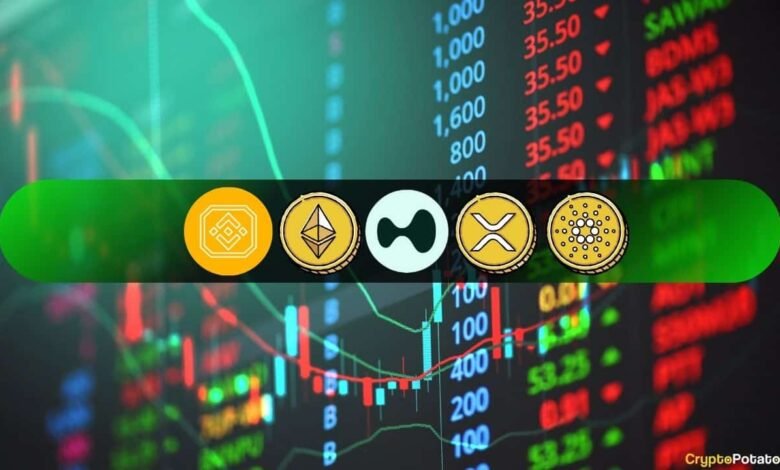ETH, XRP, ADA, BNB, and HYPE

This Friday, we examine Ethereum, Ripple, Cardano, Binance Coin, and Hyperliquid in greater detail.
Ethereum (ETH)
After a turbulent period since the October 10th crash, Ethereum managed to find its balance around the $4,000 level, which is currently acting as a key resistance. If buyers can break above this level, optimism can return. ETH also closed the week with a 6% gain.
The price action shows sellers may have become exhausted in the past two weeks, which gives bulls an opportunity for a relief rally. This can start as soon as the price moves beyond $4,000.
Looking ahead, Ethereum has to challenge the all-time high at $4,900 if it wants to make new highs this year. That requires a 20% rally from current price levels, which is still doable until the end of 2025.
Ripple (XRP)
XRP is forming an inverted head-and-shoulders reversal pattern, with strong support above $2.3. This allowed it to close the week with a 10% gain. Should the price break the resistance at $2.7 later, then it will aim for $3 next.
While buyers still appear shy right now, they are slowly returning to the order books. A price above $2.7 will confirm a bullish bias, which will likely bring back attention to XRP.
Looking ahead, the daily MACD did a bullish cross today, which is another signal that this cryptocurrency is ready to recover its most recent losses. Sellers could return at $2.7, but until then, the path is clear for higher price levels.
Cardano (ADA)
Cardano increased by 8% this week and mirrors the price action of XRP. If buyers can defend the support at $0.64, they have a good chance to approach the resistance at $0.77 next.
The momentum indicators, such as the MACD and RSI, are also turning bullish on the daily timeframe. However, the buy volume remains weak, which shows buyers are hesitant.
Looking ahead, ADA is well-positioned to recover some of its most recent losses with key targets at $0.77 and $0.90. Those two levels have to break if ADA wants to return above $1 later.
Binance Coin (BNB)
Binance Coin has been an outlier throughout 2025, managing to make new record prices several times. It also closed this week with an 8% gain.
At the time of this post, the asset is hovering around $1,100, which places it in a range between the resistance at $1,200 and support at $1,000. The all-time high is found at $1,375.
Looking ahead, if the overall market recovers in the weeks to come, BNB has a good shot at making new highs beyond its current price record.
Hype (HYPE)
HYPE is the best performer this week after an impressive rally that allowed it to close 18% higher. It also managed to push above $40, a level that was lost during the October 10th crash.
As long as buyers can hold here and keep $40 as support, HYPE has a good chance to test the resistance at $43 and even $46. With momentum shifting bullish, this cryptocurrency could enter a sustained rally.
Looking ahead, HYPE’s greatest challenge is to return above $50. If it can manage that, then new price records become possible. Until then, it’s best to watch the price action at the key targets.
Binance Free $600 (CryptoPotato Exclusive): Use this link to register a new account and receive $600 exclusive welcome offer on Binance (full details).
LIMITED OFFER for CryptoPotato readers at Bybit: Use this link to register and open a $500 FREE position on any coin!
Disclaimer: Information found on CryptoPotato is those of writers quoted. It does not represent the opinions of CryptoPotato on whether to buy, sell, or hold any investments. You are advised to conduct your own research before making any investment decisions. Use provided information at your own risk. See Disclaimer for more information.
Cryptocurrency charts by TradingView.
Source link



